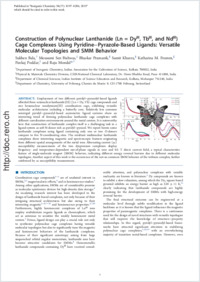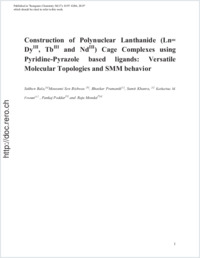Construction of polynuclear lanthanide (Ln = DyIII, TbIII, and NdIII) cage complexes using pyridine–pyrazole-based ligands: versatile molecular topologies and SMM behavior
- Bala, Sukhen Department of Inorganic Chemistry, Indian Association for the Cultivation of Science, Kolkata, India
- Bishwas, Mousumi Sen Physical & Materials Chemistry Division, CSIR-National Chemical Laboratory, Pune, India
- Pramanik, Bhaskar Department of Chemical Sciences, Indian Institute of Science Education and Research, Kolkata, Mohanpur, India
- Khanra, Sumit Department of Chemical Sciences, Indian Institute of Science Education and Research, Kolkata, Mohanpur, India
- Fromm, Katharina M. Department of Chemistry, University of Fribourg, Switzerland
- Poddar, Pankaj Physical & Materials Chemistry Division, CSIR-National Chemical Laboratory, Pune, India
- Mondal, Raju Department of Inorganic Chemistry, Indian Association for the Cultivation of Science, Kolkata, India
-
08.09.2015
Published in:
- Inorganic Chemistry. - 2015, vol. 54, no. 17, p. 8197–8206
English
Employment of two different pyridyl–pyrazolyl-based ligands afforded three octanuclear lanthanide(III) (Ln = Dy, Tb) cage compounds and one hexanuclear neodymium(III) coordination cage, exhibiting versatile molecular architectures including a butterfly core. Relatively less common semirigid pyridyl–pyrazolyl-based asymmetric ligand systems show an interesting trend of forming polynuclear lanthanide cage complexes with different coordination environments around the metal centers. It is noteworthy here that construction of lanthanide complex itself is a challenging task in a ligand system as soft N-donor rich as pyridyl–pyrazol. We report herein some lanthanide complexes using ligand containing only one or two O-donors compare to five N-coordinating sites. The resultant multinuclear lanthanide complexes show interesting magnetic and spectroscopic features originating from different spatial arrangements of the metal ions. Alternating current (ac) susceptibility measurements of the two dysprosium complexes display frequency- and temperature-dependent out-of-phase signals in zero and 0.5 T direct current field, a typical characteristic feature of single-molecule magnet (SMM) behavior, indicating different energy reversal barriers due to different molecular topologies. Another aspect of this work is the occurrence of the not-so-common SMM behavior of the terbium complex, further confirmed by ac susceptibility measurement.
- Faculty
- Faculté des sciences et de médecine
- Department
- Département de Chimie
- Language
-
- English
- Classification
- Chemistry
- License
-
License undefined
- Identifiers
-
- RERO DOC 258335
- DOI 10.1021/acs.inorgchem.5b00334
- Persistent URL
- https://folia.unifr.ch/unifr/documents/304778
Other files
Statistics
Document views: 73
File downloads:
- pdf: 222
- Supplementary material: 172
- X-ray crystallographic information for complex 2: 111
- X-ray crystallographic information for complex 1: 89
- X-ray crystallographic information for complex 3: 96
- X-ray crystallographic information for complex 4: 100


